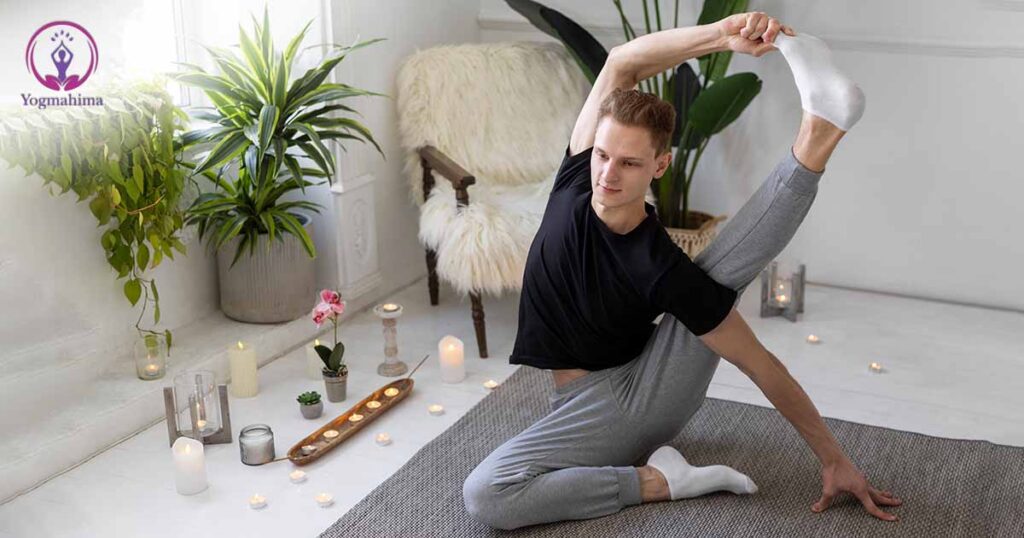
Yoga is a way of life, and those who practice it regularly maintain good mental and physical health. If practiced properly, yoga can provide endless benefits for overall body and mind development. The catch is to do it properly, either by yourself or under the guidance of an expert. Beginners tend to make some common yoga mistakes, which in turn minimize their effects on the body. The key to flexibility and strength is practicing yoga correctly, regularly, and patiently.
So, let’s look at the most common yoga mistakes of beginners.
What Are Some Common Yoga Mistakes Beginners Make?
With proper practice and awareness, you will see improvement in the physical and mental aspects of yoga as you move past these most common mistakes and start to learn yoga’s lasting sessions.
The typical yoga mistakes include:
Comparing Yourself with Others

One of the most common ways to injure yourself is to look at what the person on the next mat is doing and try to replicate the exercise they are doing. Each one has their body type and shape, so mimicking the same exercise without proper guidance can injure one. Instead, one should focus on one’s own body and exercise; if you begin to compare and push your body to that level, where your body still needs to prepare to go, you can surely make a huge mistake and will injure yourself in the course.
Rushing

One of the biggest mistakes new yogis make is to rush into new poses and exercises without perfecting their current ones. All that a beginner yogi requires to master this yoga practice is self-awareness and patience. Start slowly, learn the basics first, excel in them, and then move on to a higher level. It’s not a race where you want to win; yoga is like a marathon, where you have to spend enough time correcting the pose without making any mistakes. So avoid rushing; learn patiently what your teacher is teaching you.
Inconsistency in Your Practice
Consistency is crucial in reaping the compelling benefits of yoga. One common trend among beginners is inconsistency. Missing a few days of class can bring you back to square one, where you started. So, be consistent with your class. A consistent and steady yoga practice—ideally twice or thrice a week in the beginning—helps the body open up and gradually move further into the poses.
Pushing Through Pain

Many beginners make a big mistake when they start incorporating yoga into their extreme workout mindset of “no pain, no gain.” With yoga, you may experience some inconveniences or discomfort if you are exploring new exercises that are new to your body. That pain is a sign that something is wrong. If you feel discomfort or pain in the pose, kindly back off the pose or take the help of a yoga teacher for proper alignment.
Tend to Hold Their Breath/Forgot Their Breathe

Breathing is an essential element in any style of yoga; a yoga instructor will always remind you to focus on your breath. Some postures may be challenging and cause you to hold your breath, but one crucial thing you want to avoid is holding your breath. Holding breaths is counterproductive to the practice and can cause you to get light-headed or tired more easily. This is when it is necessary to take a deeper breath in order for your body to move into the yoga pose fully. Consistent and mindful breathing keeps your body well-oxygenated as you move from pose to pose.
Overeating Before Yoga

It is best to avoid eating before yoga because your body needs adequate time to digest the food. Plus, a full stomach may leave you feeling bloated and uncomfortable while doing yoga. Doing twisting poses with a full stomach may leave you feeling nauseous. Instead, have a very light snack, like nuts or fruit, before practicing. Staying hydrated before and after class is also a good idea.
Conclusion
If you can relate to all these problems, you must know what common yoga mistakes you are making. Avoiding these yoga mistakes will make your experience more enjoyable and effective. So these are the few yoga mistakes to avoid, and next time when you roll out the mat, observe the difference in your practice.
If you want to avoid committing any of these mistakes, it is advisable to learn and practice under the supervision of an experienced yoga instructor. Start your yoga practice with Yogmahima; it is the gateway to yoga. The school offers a diverse range of courses, from the roots of traditional Hatha and the vigor of Ashtanga yoga to the serenity of meditation and pranayama.
Join the Yogmahima community and follow a path of growth, balance, and inner harmony today.
Frequently Asked Questions (FAQs)
Q1: What are the side effects of doing wrong yoga?
A1: Practicing yoga is safe if it is done under the supervision of an instructor; otherwise, wrong alignment during poses can lead to adverse effects such as nerve damage and even stroke.
Q2: Does yoga prevent diseases?
A2: The regular practice of yoga can help prevent non-communicable diseases such as high blood pressure, diabetes, and cardiovascular illness. Yoga is also a great solution to keep chronic back pain, arthritis, and other lifestyle diseases at bay.
Q3: What are the common beginner yoga challenges?
A3: The most common challenges in yoga a beginner faces are inconsistency, pushing too complex, and delayed results.
Q4: What courses are provided by Yogmahima?
A4: Yogmahima offers classical hatha yoga classes, pregnancy yoga classes, sound healing therapies, acupressure, music, dance, and art.
Q5: What’s the first thing the beginner must know in yoga?
A5: There are a few basics to begin with; start with postures or yoga asanas for an excellent foundation.
Also Read:
7 Ways Yoga is Good for Your Mental Health
Yoga Poses for Flexibility: Poses to Increase Your Range of Motion



No Comments yet!